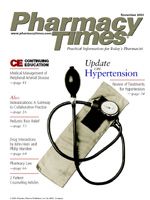Publication
Article
Pharmacy Times
Insomnia: Help for the Weary
Author(s):
Oftentimes, a patient or family member will seek advice and a recommendation from a pharmacist regarding insomnia. Insomnia can have a substantial impact on quality of life, as well as on morbidity and mortality in those cases where the insomnia is of a chronic nature. Insomnia can have enormous consequences for daytime activities, such as causing daytime fatigue, decreased concentration, and irritability. Many automobile and industrial accidents have been attributed to daytime sleepiness.
Insomnia is defined in the Diagnostic and Statistical Manual of Mental Disorders, Fourth Edition, Text Revision, as the subjective complaint of having trouble falling asleep, having difficulty maintaining sleep, or feeling insufficiently rested from sleep that causes impairment in social or work-related activities.1 Transient insomnia occurs for <3 weeks and is usually caused by situational (financial, job-related, or interpersonal events, major life changes), environmental (temperature, noise, light), or circadian rhythm disturbances (jet lag, shift work). Insomnia persisting for >4 weeks is termed persistent or chronic insomnia.2 Chronic insomnia can be caused by a variety of different factors alone or in combination with other health issues.
In either scenario, the most effective clinical strategy is to identify possible transient causes and to rule out either medical, psychological, or drug-induced etiologies. Medical causes of insomnia include pregnancy, gastrointestinal disorders, cardiovascular disease, pain, rheumatic disease, endocrine abnormalities, respiratory disorders (sleep apnea, asthma), and neurodegenerative disorders. Psychiatric causes include mood disorders (depression, mania) and generalized anxiety disorders. Drug-induced etiologies include alcohol withdrawal, stimulants, steroids, caffeine, nicotine, serotonin reuptake inhibitors, diuretics, central adrenergic blockers, and anticonvulsants.3
Assessment
Effective patient counseling begins with an assessment of whether the complaints are of a transient or chronic nature. Patients with chronic insomnia should be referred to their primary care provider to determine the etiology. Pharmacists determining the nature of patients? insomnia can use the questions listed in Table 1. If available, the bed partner may contribute valuable information to determine the extent of the problem. Responses to the listed questions will determine the management strategy for a given patient.
Management
Transient Insomnia The short-term use of sedative?hypnotics in conjunction with good sleep habits (Table 2)2,4 is appropriate for the management of transient insomnia. The duration of therapy is about 7 to 10 days; reassessment is recommended if therapy goes beyond 2 to 3 weeks. Pharmacologic options include nonbenzodiazepine hypnotics?such as zolpidem and zaleplon ?or benzodiazepine hypnotics?such as estazolam, flurazepam, quazepam, temazepam, and triazolam. These agents have demonstrated efficacy in decreasing sleep latency and increasing total sleep time.
The onset of activity and the duration of action are pertinent pharmacokinetic parameters. Long-acting benzodiazepines are best avoided in the elderly to prevent daytime sedation, falls, and fractures. Agents that act more rapidly are best for patients whose complaint is falling asleep rather than staying asleep. Excess daytime sedation and anterograde amnesia are possible with these agents. Patients need to be made aware of the possibility of impaired morning-after motor performance. Patients also need to be informed that rebound insomnia can occur after discontinuing benzodiazepine hypnotics. Nonprescription antihistamines possess anticholinergic side effects and are less effective than the benzodiazepines, so these agents are poor choices for the older population.
Chronic Insomnia
Chronic insomnia can be treated effectively with nonpharmacologic therapy.3,5-7 Nonpharmacologic alternatives ?such as sleep hygiene, stimulus control, sleep restriction, cognitive therapy, multicomponent therapy, and paradoxical intention?have been shown to be more effective than pharmacologic therapy in older patients.8 These nonpharmacologic alternatives have been shown to have a sustained effect for at least 6 months after discontinuation.9 Additionally, the nonpharmacologic therapies tend to be more successful if tried prior to pharmacologic interventions. 4 In cases where the cognitive, behavioral, and educational therapies have been ineffective or only partially effective, the addition of pharmacotherapy options can be explored.10
Therapeutic options include nonbenzodiazepines, benzodiazepines, antidepressants, and herbal remedies. Tricyclic antidepressants are rarely used because of their cardiovascular, anticholinergic, and overdose potential. The herbal medications used in the treatment of insomnia are L-tryptophan, valerian, and melatonin. The safety and efficacy of these products has not been consistently demonstrated in randomized clinical trials. In addition, there is variability in the concentration of the active ingredient between different manufacturers? products.
Conclusion
Strategies for the effective treatment of transient and chronic insomnia include nonpharmacologic and pharmacologic interventions. Irrespective of the empiric choice of drug therapy, patients should be counseled as well as being monitored for the efficacy and toxicity of drug therapy. Pharmacists need to reinforce the importance of avoiding alcohol and other central nervous system depressants, impaired motor coordination, excess daytime sedation, and rebound insomnia.







